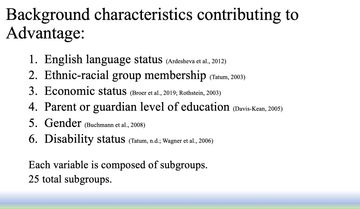Fast facts about the Advantage Framework
Teachers have access to measures of achievement, but not measures of opportunity.
Measures of opportunity provide useful context for interpreting achievement.
Advantage is a measure of individual-level opportunity.
The Cambridge dictionary defines advantage as "a condition giving greater chance at success."
The Advantage framework is a subset of opportunity. Whereas opportunity implies an element of choice, the Advantage variables are inherited and outside the control of the student.
Additionally, the Advantage framework focuses on variables that apply to every student and are commonly collected in educational settings.
Students' measures of opportunity are the sum of the variables in the Advantage framework. Just as every student has measures of achievement, every student can have a measure of advantage.
- The Advantage framework was intentionally designed to be meaningful to educators and understandable to a wide range of users.
- Similar to achievement, Advantage is a continuous variable. Continuous variables better represents individual students.
- The Advantage framework embraces the complexity of students overlapping characteristics.
- The Advantage framework always includes every student.
- Advantage does not reinforce harmful stereotypes about group membership (e.g, gender, race/ethnicity, disability status, etc.).
- Measures of Advantage are generated from actual student data and thus are always relevant to your students.
- Context when interpreting achievement at the individual, classroom, school, district, or state level.
- Context for classes. Every class can be described both by the achievement of its students but also by the students' levels of Advantage.
- As a measure for determining resource allocation.
- As an indicator for designing and evaluating programs or interventions.
- A measure for balancing classrooms, schools, and teacher work loads.
Origins of the Advantage Framework
I developed the Advantage framework as part of my dissertation at the University of California, Berkeley. I began with a conceptual framework to define educational Advantage, relying heavily on the perspectives of educators, operationalized the model to generate individual-level measures of educational opportunity, and evaluated the Advantage framework using cross-sectional, longitudinal, and state-level data.
The three papers had the following goals:
- Paper One: Established the validity, reliability, and functional utility of the Advantage framework.
- Paper Two: Evaluated the Advantage framework using longitudinal achievement data for Grades 3–8.
- Paper Three: Evaluated changes in the inequality of opportunity in California schools pre- and post-COVID (2015–2019 & 2022–2024) using measures of school-level mean Advantage.
I provide a brief introduction to the Advantage framework below.
© David Stevens, 2025
A Brief introduction to the Advantage Framework
A Brief Introduction to the Advantage Framework


Exposure to greater opportunity is associated with higher achievement.

Unlike achievement, opportunity lacks a common method of measurement.

Achievement inequality is often discussed as categorical.

Achievement is best represented by a continuous variable.

Opportunity is also a continuous.
Conceptual Framework for Advantage

The goal.

The reality.

What is needed.

"Opportunity Gap"

Limitations of the opportunity gap framework.

Advantage, not opportunity.

How might you measure Individual-level Advantage?

Achievement = Effort + Opportunity

What variables should be included in the framework?

Teacher-centered framework.

Advantage is an individual-level measure.

Group vs. individual-centered analyses.
Using the Advantage framework to more effectively address inequality

Advantage functions at all levels of analysis.
© David Stevens, 2024

Advantage adds a second dimension (context) for interpreting achievement.
© David Stevens, 2024

Advantage (opportunity) varies widely within groups.
© David Stevens, 2024

Advantage and Achievement vary widely within groups.
© David Stevens, 2024

Advantage explains within-group achievement.
© David Stevens, 2024

Advantage explains group-based differences proficiency.
© David Stevens, 2024

Advantage helps identify where to focus resources and intervention.
© David Stevens, 2024

© David Stevens, 2025
A Brief introduction to the Advantage Framework
A Brief Introduction to the Advantage Framework


Exposure to greater opportunity is associated with higher achievement.

Unlike achievement, opportunity lacks a common method of measurement.

Achievement inequality is often discussed as categorical.

Achievement inequality is better represented as continuous.

The same is true for the inequality of opportunity.
Conceptual Framework for Advantage

The goal.

The reality.

What is needed.

"Opportunity Gap"

Limitations of the opportunity gap framework.

Advantage, not opportunity.

How might you measure Individual-level Advantage?

Achievement = Effort + Opportunity

What variables should be included in the framework?

Teacher-centered framework.

Advantage is an individual-level measure.

Group vs. individual-centered analyses.
Using the Advantage framework to more effectively address inequality

Advantage functions at all levels of analysis.
© David Stevens, 2024

Advantage adds a second dimension (context) for interpreting achievement.
© David Stevens, 2024

Advantage (opportunity) varies widely within groups.
© David Stevens, 2024

Advantage and Achievement vary widely within groups.
© David Stevens, 2024

Advantage explains within-group achievement.
© David Stevens, 2024

Advantage explains group-based differences proficiency.
© David Stevens, 2024

Advantage helps identify where to focus resources and intervention.
© David Stevens, 2024

© David Stevens, 2025
Contact me
Academic Support Index
This website uses cookies.
We use cookies to analyze website traffic and optimize your website experience. By accepting our use of cookies, your data will be aggregated with all other user data.